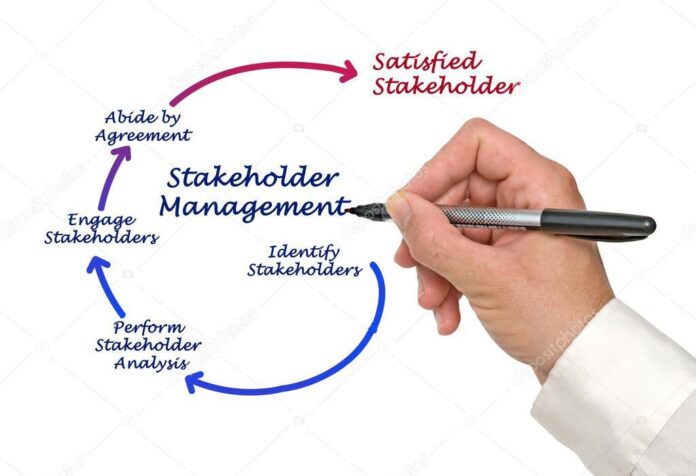
Stakeholders in your project are interested in the results. Some, such as the sponsor, steering committee, and project team members, are more vital to the project’s success. Others, such as subject matter experts, cross-functional managers, and vendors, are equally vital but are only participating in parts of the project. But, regardless of their function, all of your stakeholders are important, and managing them well may make a major difference in your project’s success.
Good project managers start by identifying stakeholders, understanding their roles in the project, determining their project-related expectations, and, in relation to other stakeholders, verifying common expectations while resolving conflicting expectations. Once this is completed, the true work of managing stakeholders begins.
What is a Stakeholder?

Project managers are in charge of overseeing their projects from start to finish, which includes managing the performance and/or expectations of people who aren’t under their direct authority but have a stake in the outcome. Anyone who is interested in a project or who will be impacted by its deliverables or results is referred to as a stakeholder.
Let’s imagine you’re in charge of a project that will allow a company to take online sales orders through their website. The Head of Sales (who will most likely be the project sponsor), a sales manager representing the internal end user group, a store/warehouse manager representing the internal end user group on the supply-chain side, an IT manager who will provide the systems solutions for your project, and a group of customers who will represent the external end user group are the most likely stakeholders for this project.
What is Stakeholder Management?

It is critical to manage the stakeholders and their expectations. As a result, Stakeholder Management is a crucial part of Project Management. All project stakeholders should be identified. Small projects may have a small number of stakeholders, but larger projects may have many. It is unlikely that all stakeholders will be treated fairly. Each person’s needs and expectations will be different.
As a result, each stakeholder must be identified. This guarantees that no stakeholders go unnoticed. The next stage is to categorize the stakeholders in order to properly include them. You’re less likely to forget anything vital if you have both of these in place.
Companies who recognize the value of actively creating and maintaining relationships with affected communities and other stakeholders benefit from enhanced risk management, stronger stakeholder support, and improved outcomes on the ground. You can use stakeholder management software like Borealis to make your work smoother.
Stakeholder Management’s Importance
Stakeholder management is unquestionably critical to a successful project relationship. Stakeholder management entails forging positive relationships with all stakeholders and gaining a thorough grasp of how their efforts contribute to the project’s overall success. This is something you must remember at all times: stakeholders might establish limits or expectations based on their previous experiences, projects, and delivery. Managing your stakeholders, on the other hand, will assist you in identifying potential project difficulties and hazards.

-
Create A Detailed Profile Of Your Stakeholders
Stakeholder management software should be able to profile and segment your stakeholders on a multidimensional level, tying them to events, personnel, teams, issues, locations, and projects, among other things. It serves as both a history book for your stakeholders and a glimpse into the future, helping you to forecast events.
-
For Support
Some stakeholders are extremely proactive, meaning you can get a lot of help for free. You can delegate to your stakeholders and involve them in various duties as long as you have confirmed that they are willing to participate in this way from the start. Stakeholders can be valuable additions to the team, and if they agree, you should be as well. Determine their level of expertise and enthusiasm for the project. Ask them to walk you through it if they’re an expert in budgeting. Again, if they are social media experts, tap into this resource and request their participation. You can consider them to be an additional member of your team as long as you have specified terms from the start.
-
Determine The Risk And Take Steps To Mitigate It
Stakeholder management that is excellent removes and minimizes certain concerns while simultaneously creating new ones. The stronger your risk management plan is, the more active communication you have with your stakeholders. You should also keep in mind that everyone working in your project has the capacity to spot new dangers that others may have missed. The more involved you are with them, the more likely you are to identify problems or behaviors that could affect your project.

-
Effective Relationship Management
Developing positive relationships with important stakeholders improves your company’s operating license. This means that local communities, civil society organizations, and other groups will continue to approve of your organization’s existence and commercial activity. It’s vital to build confidence and legitimacy through deliberate stakeholder management, especially if your actions have a direct or indirect impact on the lives or natural environment of nearby populations.
-
Build Trust
When you communicate with stakeholders, you’re showing them that you care about their opinions. This cooperative approach aids in the development of trust and goodwill for you and your company. This is especially beneficial if you’re dealing with a crisis; restoring trust can be a lengthy, difficult process, but it begins with ensuring that all of your stakeholders have a place at the table.
-
Strategic Plan
Stakeholder management is crucial when it comes to strategic planning. It’s critical that your stakeholders comprehend why you’re in business, where you intend to go, and how you’ll get there. Furthermore, it’s critical that your key stakeholders (see the part below on stakeholder mapping) are aligned with and bought into your organization’s strategic direction so that they can become champions who can assist you realize your goal and vision.

Conclusion
Project managers should have a comprehensive stakeholder management plan in place that is tailored to their particular project. The goal of the stakeholder management plan is to engage your stakeholders and build strong relationships with them by creating goals and managing expectations.
Stakeholders have a strong stake in a project’s success or failure, yet they often have divergent perspectives about how to make it succeed. Stakeholder management plans can be an effective tool for bringing stakeholders together by laying out a common path for achieving project goals.
















